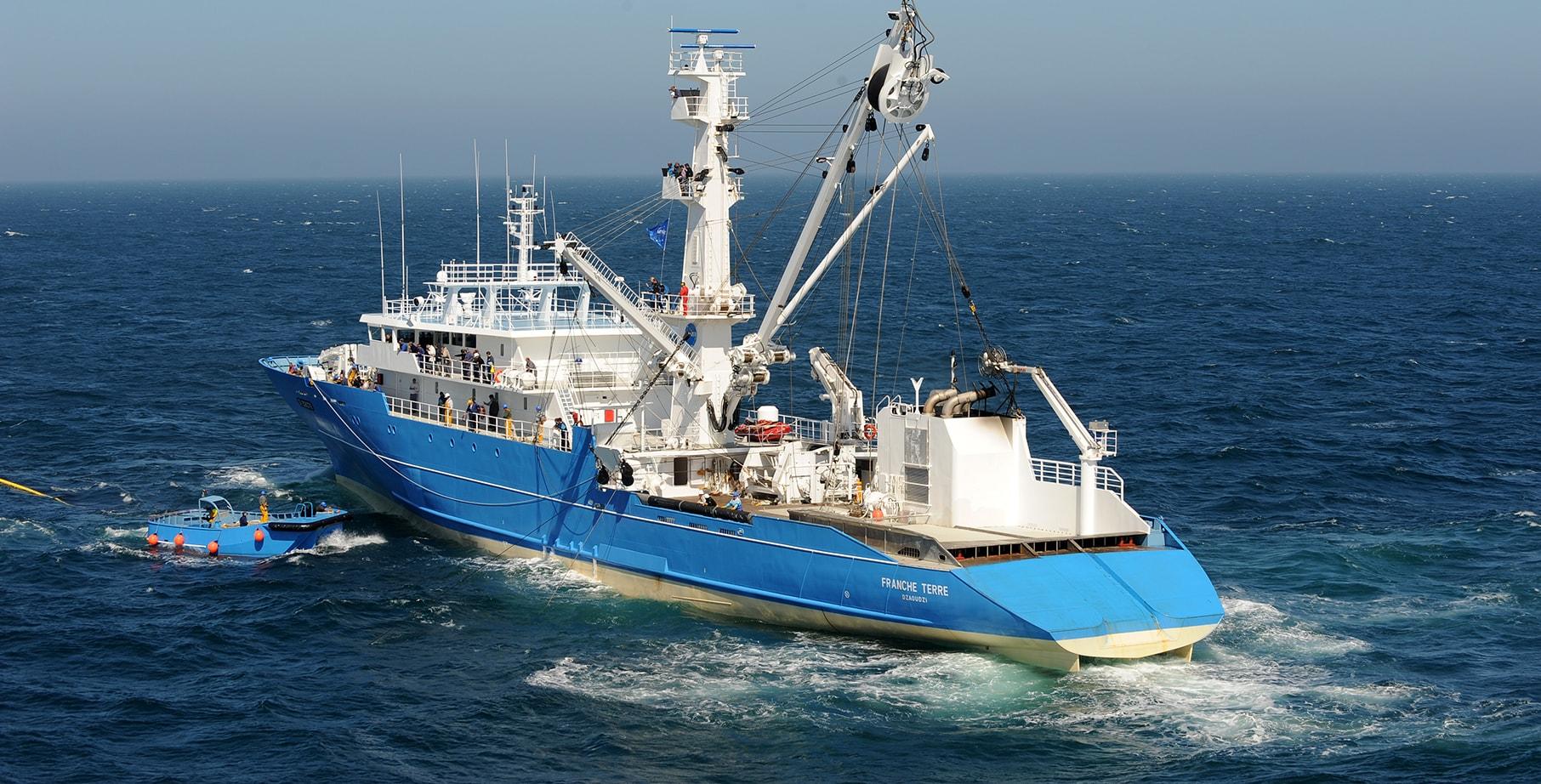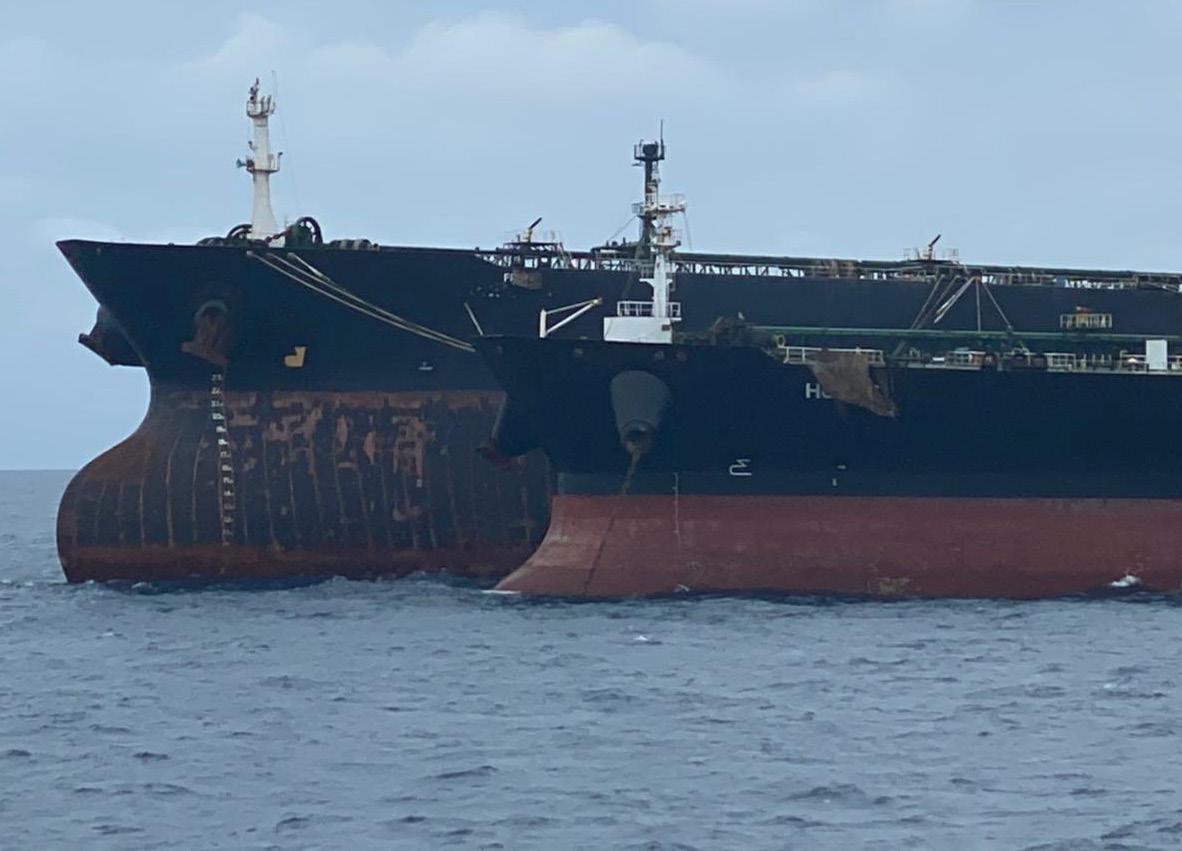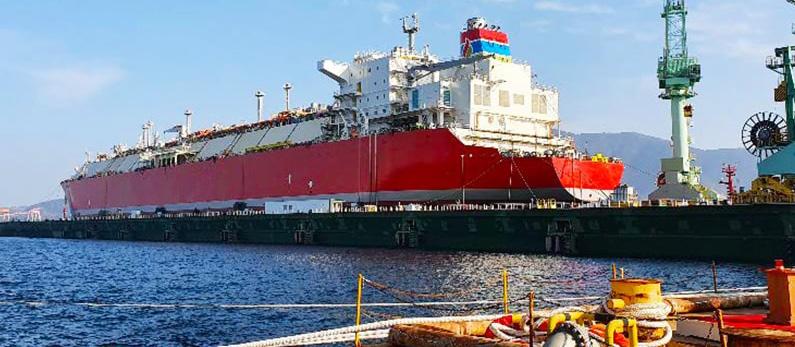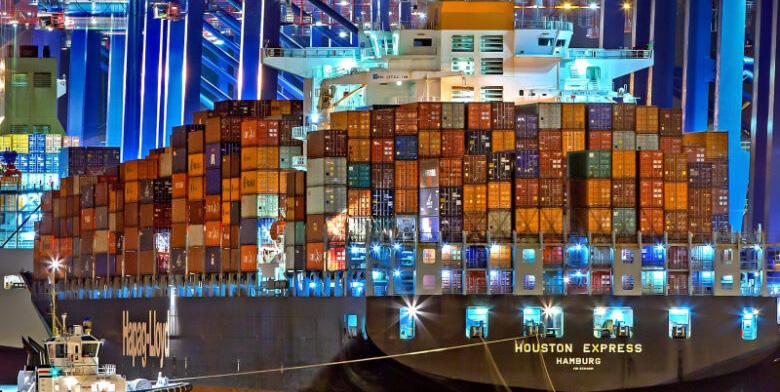
9 minute read
BHS) : Rekor Dunia Baru Untuk Tarif Pengiriman: USD350.000 Per Hari (ENG) : New World Record Set For Shipping Rates: USD350.000 Per Day
REKOR DUNIA BARU UNTUK TARIF PENGIRIMAN : USD 350.000 PER HARI
Tidak pernah semahal ini untuk mengirimkan satu kontainer barang melintasi lautan. Tetapi itu bukan hanya kontainer. Pengapalan gas alam cair (LNG) juga mencatatkan rekor baru. Argus melaporkan bahwa BP telah mencarter kapal LNG Abalamabie dengan harga setara USD350,000 per hari. Itu menjadikannya salah satu harga sewa kapal kargo termahal dalam sejarah, melampaui USD300,00 per hari yang sebelumnya tercatat di segmen kapal induk berukuran besar (VLCC). Apa perbedaan antara rekor LNG record — dibandingkan dengan kapal kontainer dan pengiriman minyak mentah yaitu kesepakatan LNG tetap sangat menguntungkan bagi pengirim kargo. Harga LNG di Asia kini lebih tinggi daripada harga di AS sehingga pengirim dapat mengantongi keuntungan yang lebih besar bahkan ketika membayar tarif rekor untuk mengangkut dari Atlantik ke Cekungan Pasifik. Ketika sektor VLCC mencapai puncaknya, biaya transportasi minyak mentah mencapai titik di mana mereka menghapus margin penyulingan; penyuling berhenti memesan kargo dan harga turun kembali. Dalam sektor kontainer, tarif tampaknya mendekati titik di mana mereka menghapus margin keuntungan importir. Beberapa importir bahkan mungkin mengangkut barang mereka ketika mereka harus menjual dengan kerugian, karena alternatifnya adalah untuk menghentikan impor dan kehilangan pangsa pasar terhadap pesaing. Dalam pengapalan LNG, ada banya ruang untuk kenaikan tarif serta memberikan keuntungan dari pergerakan barang bagi pengirim dan pedagang. Masalahnya sama dengan yang terjadi di sektor kontainer yaitu tidak cukup kapal LNG untuk menangani permintaan.
Mengapa tarif pengapalan LNG begitu tinggi? Clarksons Platou Securities menjelaskan, “Penilaian Platts Far East melampaui USD 21 Dolar Amerika per MMBtu [jutaan unit termal Inggris] pada akhir pekan lalu, dibandingkan dengan harga gas alam di Henry Hub AS, harga gas alam berada di bawah USD 2 Dolar Amerika per MMBtu. “Ini telah memicu permintaan pengapalan LNG, mengakibatkan tarif naik di atas USD 300.000 Dolar Amerika per hari. Sementara tarifnye melonjak, biaya pengiriman berkisar sekitar USD 5,50 Dolar Amerika per MMBtu masih di bawah 18 Dolar Amerika per MMBtu di wilayah tersebut,” kata Clarksons. Clarksons menilai tarif rata-rata untuk pengangkut LNG dua tak modern sebesar USD 215.000 Dolar Amerika per hari. Pada saat ini di tahun lalu, tarif untuk kapal yang sebanding adalah USD 103.000 Dolar Amerika per hari. Tetapi beberapa perusahaan pengiriman tidak dapat menemukan kapal untuk dimuat bahkan ketika menawarkan untuk membayar tarif Buku Rekor Guinness. Menurut Argus, “Sejumlah penanggung jawab AS memilih untuk menurunkan volume bulan Februari di bulan Desember, karena ketidak mampuan untuk menemukan kapal untuk memuat kargo kontraktual mereka. Para penanggung jawab yang memilih untuk menurunkan volume Februari mereka kini menemukan diri mereka dengan kargo namun kekurangan tonase.”
Berapa lama kenaikan harga akan bertahan? Dalam kasus pengiriman kontainer, COVID telah menyebabkan kenaikan tarif di mana pelanggan beralih dari membeli layanan menjadi membeli barang. Dalam kasus LNG, tarif pengiriman telah didorong akibat musim dingin yang parah di Asia (LNG digunakan untuk menghasilkan tenaga untuk pemanas), kekurangan produksi LNG di Asia dan kemacetan di Terusan Panama. Menurut analis pengapalan Stifel, Ben Nolam, “Keteganggan …tentunya akan mereda dengan cuaca yang membaik. Namun, kami percaya bahwa harga yang mahal mencerminkan permintaan yang tetap tinggi bahkan setelah pergantian musim.” Menurut analis Jefferies, Randy Giveans, “Kami mengharapkan tarif pengangkut LNG akan tetap kuat selama Kuartal pertama tahun 2021 karena jendela arbitrase tetap terbuka.” Bangunan baru sedang dibangun Toby Dunipace, kepala bagian agensi gas SSY, bersikap lesu terhadap prospek setelah Kuartal 1. Salah satu alasan keprihatinan adalah banyakannya pembangunan baru yang akan segera dibangun. Berbeda dengan industri kontainer, di mana pesanan selalu rendah, pesanan LNG kini sangat luar biasa. Alphaliner memperkirakan pemesanan kapal kontainer hanya mewakili 10,4% dari kapasitas armada. Menurut Clarksons, rasio pemesanan dibanding jumlah kapal seharusnya lebih dari dua kali lipat, yaitu di angka 26,1%. Dalam prospektus tahunan SSY yang dirilis pada hari Senin, Dunipace memperingatkan, “Pasar [LNG] kemungkinan besar akan menurun paling lambat di bulan Maret, ketika jumlah bangunan LNG yang cukup sudah siap. Bangunan baru akan terus selesai pada Kuartal 2 dan Kuartal 3, dan kapal juga tetap akan disewa selama periode ini. Secara keseluruhan, proyeksi market sangat lesuh untuk Kuartal 2 dan Kuartal 3 tahun 2021.
Eksposur Spot, tempat yang tepat, waktu yang tepat Dalam waktu dekat, perusahaan LNG yang terdatar dengan kapal di pasar spot atau dengan sewa tarif variabel akan diuntungkan. Pada panggilan konferensi tanggal 17 November, Direktur Utama Flex LNG (NYSE: FLNG) Øystein Kalleklev melaporkan bahwa perusahaannya memiliki tiga kapal dengan masa sewa yang ditetapkan, tiga dengan masa waktu variabel dan empat di pasar spot. Harga saham Flex LNG naik 68% dalam enam bulan terakhir. Golar LNG (NYSE: GLNG) memiliki eksposur non-LNG yang lebih sedikit. has less exposure to current rates, as well as significant non-LNG exposure. Iain Ross, Direktur Utama Golar, mengatakan pada konferensi tanggal 30 November, “Kami memiliki kapal dengan sewa terkait indeks dan beberapa kapal yang berpotensi berada di pasar spot. Namun mayoritas dari armada menggunakan struktur tarif tetap, beberapa bahkan mencapai satu tahun dan lebih lama.” Pada tanggal 10 November, GasLog LNG (NYSE: GLOG) melaporkan setengah dari kapalnya berada di pasar jangka pendek atau pasar spot, atau memiliki sewa variabel. Namun bahkan bagi perusahaan dengan eksposur spot, pada akhirnya tetap bergantung pada waktu. Perjalanan pulang pergi dari AS ke Asia memakan waktu dua hingga tiga bulan. Sangat sedikit pengangkut LNG yang berada di pasar spot, menganggur dan berada di posisi yang tepat untuk mengambil keuntungan dari tarif yang belum pernah ada sebelumnya. Dinamika yang sama juga terjadi di pasar VLCC pada bulan Oktober 2019 dan bulan Maret 2020. Berita utama tentang tairf tertinggi yang pernah dilaporkan. Namun hanya segelintir pemilik kapal yang memiliki kapal tanker untuk benar-benar mengambil keuntungan dari tarif tersebut.

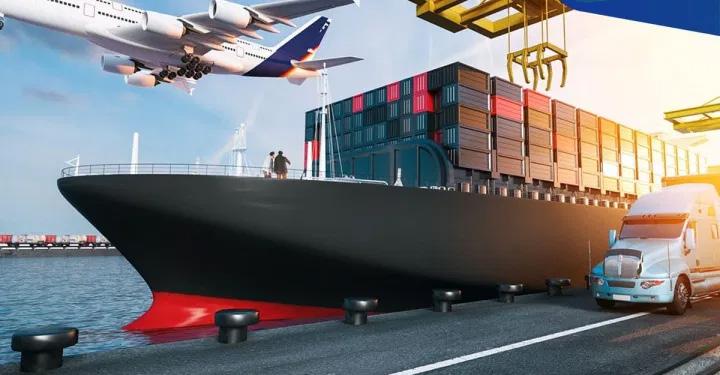
NEW WORLD RECORD SET FOR SHIPPING RATES : USD350.000 PER DAY
It has never been more expensive to get a container of goods across the ocean. But it’s not just containers. Liquified natural gas (LNG) shipping is also rewriting the record books. Argus reported that BP has just chartered the ship LNG Abalamabie for the equivalent of USD350,000 per day. That makes it the most expensive cargo-ship charter in history, surpassing the USD300,000-per-day peak previously recorded in the very large crude carrier (VLCC) segment. What’s different about the LNG record compared to container and crude shipping highs is that LNG deals remain extremely profitable for cargo shippers. The cost of LNG in Asia is now so much higher than the cost in the U.S. that shippers can pocket massive profits even when paying record rates to transport cargoes from the Atlantic to the Pacific Basin. When the VLCC sector hit its pinnacle, crude transport costs reached the point where they erased refiners’ margins; refiners stopped booking cargoes and rates fell back. In the container sector, rates appear to be near the point where they erase importer profit margins. Some importers may even be transporting goods they will have to sell at a loss, because the alternative is to halt imports and lose market share to competitors. In LNG shipping, there is plenty of room for rates to rise and for shippers and traders to still profit on the cargo move. The problem similar to what is happening in the container sector is that there are not enough LNG ships in existence to handle demand.
Why LNG shipping rates are so high?
How long could rate spike last? Newbuilds in the pipeline
Spot exposure, right place, right time
Clarksons Platou Securities explained, “The Platts Far East assessment surpassed USD21 per MMBtu [million British thermal units] at the end of last week, which compares to U.S. Henry Hub natural gas prices below USD2 per MMBtu. “This has fueled LNG spot vessel demand, leading to rates above USD300,000 per day. While the rate jumps off the page, the freight cost equates to around USD5.50 per MMBtu well within the wide USD18 per MMBtu spread between the regions,” said Clarksons. Clarksons assessed average rates for modern two-stroke LNG carriers at USD215,000 per day. At this time last year, rates for a comparable ship were USD103,000 per day. But some shippers cannot find vessels to load even when offering to pay Guinness Book rates. According to Argus, “A number of U.S. offtakers opted to turn down February volumes in December, because of an inability to find the vessels to load their contractual cargoes. Offtakers that opted not to turn down their February volumes are now finding themselves with cargoes that they cannot find the tonnage [for].”
In the case of container shipping, COVID has supercharged rates as consumers switch purchasing from services to goods. In the case of LNG, shipping rates have been driven up by extreme winter weather in Asia (LNG is used to generate power for heating), LNG production outages in Asia and Panama Canal congestion. According to Stifel shipping analyst Ben Nolan, “The tightness will doubtless ease with moderating weather. However, we believe the fact that prices are as high as they are is indicative of stronger underlying demand even after seasonal adjustments.” According to Jefferies analyst Randy Giveans, “We expect LNG carrier spot rates will remain robust during Q1 2021 as the arb [arbitrage] window remains open.” Toby Dunipace, head of gas at brokerage SSY, is bearish on the prospects beyond Q1. One reason for concern is the large wave of newbuildings about to be delivered. Unlike the container industry, where ordering has been low, the LNG orderbook is prodigious. Alphaliner estimated that the container-ship orderbook represents just 10.4% of the capacity of the on-the-water fleet. According to Clarksons, the orderbook-to-fleet ratio in LNG shipping is more than double that, at 26.1%. In SSY’s annual outlook released Monday, Dunipace warned, “The [LNG] market will more than likely slide during March at the latest, when a significant amount of LNG newbuildings are delivered. Newbuildings will continue to deliver through Q2 and Q3 and ships also come off time charter during this period. Overall, the market projections are very bearish for Q2 and Q3 2021.”
In the near term, listed LNG companies with ships in the spot market or with variable-rate time charters stand to benefit. On the Nov. 17 conference call, Flex LNG (NYSE: FLNG) CEO Øystein Kalleklev reported that his company has three ships on fixed time charters, three on variable hire and four in the spot market. Flex LNG’s share price is up 68% over the past six months. Golar LNG (NYSE: GLNG) has less exposure to current rates, as well as significant non-LNG exposure. Iain Ross, Golar’s CEO, said on the company’s Nov. 30 call, “We do have ships on index-linked charters and a couple of ships that could potentially be in the spot market. But the vast majority of the fleet is on a fixed-rate structure, some of it up to a year and some slightly longer.” On Nov. 10, GasLog LNG (NYSE: GLOG) reported that half of its ships were in the short-term or spot market, or had variable charters. But even for companies with spot exposure, it ultimately comes down to timing. A round-trip voyage from the U.S. to Asia takes two to three months. Very few LNG carriers are on spot, unemployed and in the right position to take advantage of today’s unprecedented rates. The same dynamic held true in the VLCC market in October 2019 and March 2020. Headlines blared about the highest reported rate. Yet only a handful of owners had tankers in position to actually earn the rates in the headlines.




